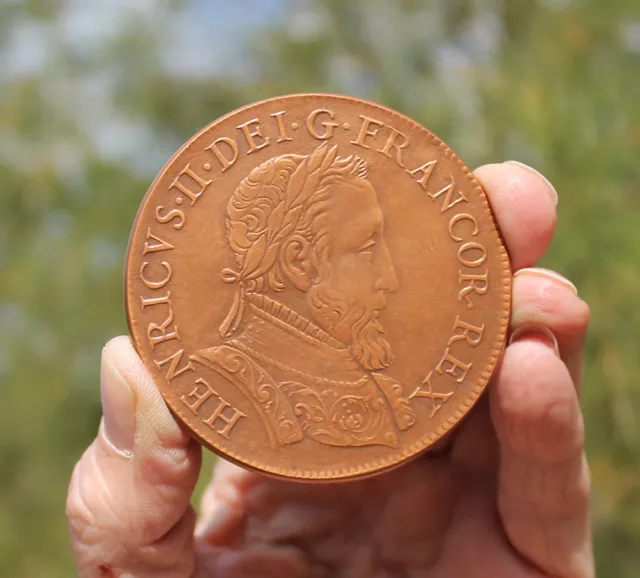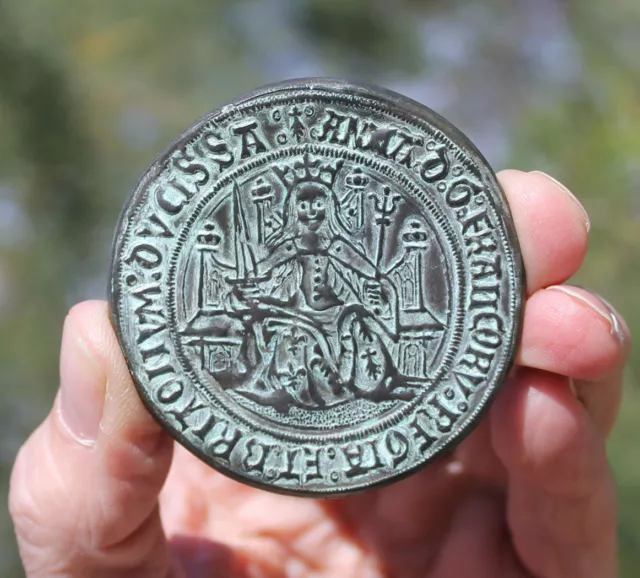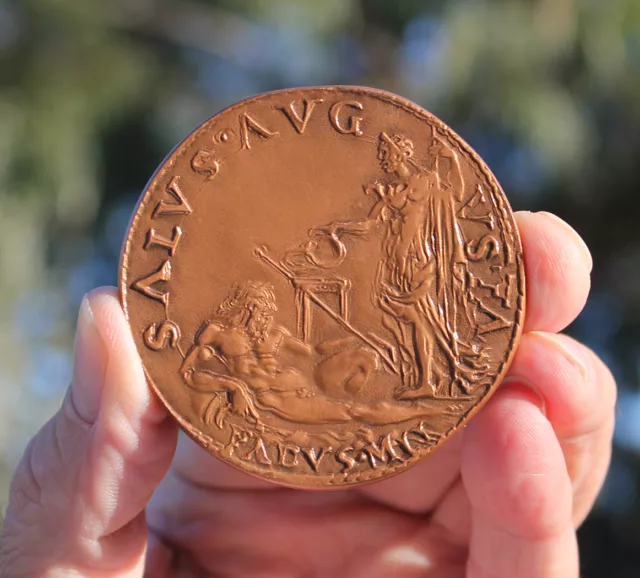CR, French medaille, Spain, Charles V, teston,149/500
Visit my page with the offers, please.
You will find many interesting items related to this subject.
If you are interested in other medals, related to this subject, click here, please.
France, related to
Ancient World, Mythology
This contemporary French medaille has been minted in Paris Mint to commemorate the teston of the Emperor CHARLES V, 1500 - 1558.
This medal has been designed minted in 500 pieces (100 in silver, 400 in bronze).
This one has the number 149/500 on the reverse.
Charles V ( French : Charles Quint ; German : Karl V. ) (24 February 1500 – 21 September 1558), also known as Charles I of Spain ( Spanish : Carlos I ), was Duke of Burgundy and ruler of the Netherlands from 1506, ruler of the Spanish Empire from 1516 and Holy Roman Emperor from 1519, until he voluntarily stepped down from these and other positions by a series of abdications between 1554 and 1556. Through inheritance, he brought together under his rule extensive territories in central, western, and southern Europe, and the Spanish colonies in the Americas and Asia. As a result, his domains spanned nearly four million square kilometers, and were the first to be described as " the empire on which the sun never sets ".
The Duchy of Milan was a constituent state of the Holy Roman Empire in northern Italy . It was created in 1395, when it included twenty-six towns and the wide rural area of the middle Padan Plain east of the hills of Montferrat . During much of its existence, it was wedged between Savoy to the west, Venice to the east, the Swiss Confederacy to the north, and separated from the Mediterranean by Genoa to the south. The Duchy eventually fell to Habsburg Austria with the Treaty of Baden (1714) , concluding the War of the Spanish Succession . The Duchy remained an Austrian possession until 1796, when a French army under Napoleon Bonaparte conquered it, and it ceased to exist a year later as a result of the Treaty of Campo Formio , when Austria ceded it to the new Cisalpine Republic .
After the defeat of Napoleon, the Congress of Vienna of 1815 restored many other states which he had destroyed, but not the Duchy of Milan. Instead, its former territory became part of the Kingdom of Lombardy–Venetia , with the Emperor of Austria as its king. In 1859, Lombardy was ceded to the Kingdom of Piedmont-Sardinia , which would become the Kingdom of Italy in 1861.
av. Charles V
rv. Salus
diameter – 63 mm, (2½”)
weight – 143.90 gr, (5.08 oz)
metal – bronze, authentic patina
Charles was the heir of three of Europe's leading dynasties: the Houses of Habsburg , Valois-Burgundy and Trastámara . From his own dynasty, the Habsburgs, he inherited Austria and other lands in central Europe . He was also elected to succeed his Habsburg grandfather, Maximilian I as Holy Roman Emperor, a title held by the Habsburgs since 1440. He inherited the Burgundian Netherlands and the Franche-Comté as heir of the House of Valois-Burgundy. From the Spanish House of Trastámara, he inherited the crowns of Castile , which was in the process of developing a nascent empire in the Americas and Asia, and Aragon . The latter included a Mediterranean empire that extended to Southern Italy . Charles was the first king to rule Castile and Aragon simultaneously in his own right, and, as a result, is sometimes referred to as the first King of Spain . [5] The personal union , under Charles, of the Holy Roman Empire with the Spanish empire resulted in the closest Europe would come to a universal monarchy in the post-classical era .
Fearing that his vast inheritance would lead to the realization of a universal monarchy and that he was trying to create a European hegemony, Charles was the object of hostility from many enemies. [7] His reign was dominated by war, and particularly by three major simultaneous conflicts: the Habsburg-Valois Wars with France, the struggle to halt the Ottoman advance , and the Protestant Reformation resulting in conflict with the German princes. The wars with France, mainly fought in Italy, resulted in recovery of territory lost at the beginning of his reign and included the decisive defeat and capture of Francis I of France at the Battle of Pavia in 1525. France recovered and the wars continued for the remainder of Charles's reign. Enormously expensive, they led to the development of the first modern professional army in Europe, the Tercios . The struggle with the Ottoman Empire was fought in Hungary and the Mediterranean. After seizing most of eastern and central Hungary in 1526, the Ottomans’ advance was halted at their failed Siege of Vienna in 1529. A lengthy war of attrition, conducted on his behalf by his younger brother Ferdinand , continued for the rest of Charles's reign. In the Mediterranean, although there were some successes, Charles was unable to prevent the Ottomans’ increasing naval dominance and the piratical activity of the Barbary Corsairs . Charles opposed the Reformation and in Germany he was in conflict with the Protestant Princes of the Schmalkaldic League who were motivated by both religious and political opposition to him. He could not prevent the spread of Protestantism and although he won a decisive victory against the Princes at the Battle of Mühlberg , 1547, he was ultimately forced to concede the Peace of Augsburg of 1555 which divided Germany on confessional lines.
Though rebellions were not something that Charles concerned himself with frequently, he was quick to put down three particularly dangerous rebellions in the vital territories of Castile , the Frisian lands , and later in his reign in the port city of Ghent . However, once the rebellions were quelled the essential Castilian and Burgundian territories remained mostly loyal to Charles throughout his rule.
Charles’s Spanish dominions were the chief source of his power and wealth. As his reign progressed, his Spanish realms became increasingly important. In the Americas, Charles sanctioned the conquest by Castillian conquistadors of the Aztec and Inca empires. Castillian control was extended across much of South and Central America. The resulting vast expansion of territory and the flows of South American silver to Castile had profound long term effects on Spain.
Charles was only 56 when he abdicated, but after 34 years of energetic rule he was physically exhausted and sought the peace of a monastery where he died at the age of 58. On Charles’s abdications, the title of Holy Roman Emperor passed to his younger brother Ferdinand (who had already been given the Austrian lands in 1521) and the Spanish Empire, including the possessions in the Netherlands and Italy, was inherited by Charles’s son Philip II . The two empires would remain allies until the 18th century.
Conflicts with the Ottoman Empire
Charles fought continually with the Ottoman Empire and its sultan, Suleiman the Magnificent . The great Hungarian defeat at the 1526 Battle of Mohács "sent a wave of terror over Europe."
The Muslim advance in Central Europe was halted at Vienna .
However, the contest between Charles and Suleiman for the mastery of the Mediterranean was decided in favor of the Sultan, in spite of Spanish victories such as the conquest of Tunis in 1535 . The regular Ottoman fleet came to dominate the Eastern Mediterranean after its victory at Preveza in 1538 and the loss of Djerba in 1560 (shortly after Charles's death), which severely decimated the Spanish marine arm. At the same time, the Muslim Barbary corsairs , acting under the general authority and supervision of the Sultan, regularly devastated the Spanish and Italian coasts, crippling Spanish trade and chipping at the foundations of Habsburg power.
In 1536 Francis I of France allied himself with Suleiman against Charles. While Francis was persuaded to sign a peace treaty in 1538, he again allied himself with the Ottomans in 1542 in a Franco-Ottoman alliance . In 1543 Charles allied himself with Henry VIII and forced Francis to sign the Truce of Crépy-en-Laonnois . Later, in 1547, Charles signed a humiliating treaty with the Ottomans to gain himself some respite from the huge expenses of their war. – and was referred to as only the King of Spain since there could only be one Emperor in the world and it was Suleiman. However, the Protestant powers in the Imperial Diet often voted against money for his Turkish wars , as many Protestants saw the Muslim advance as a counterweight to the Catholic powers.
Charles V made overtures to the Safavid Empire to open a second front against the Ottomans, in an attempt at creating a Habsburg-Persian alliance . Contacts were positive, but rendered difficult by enormous distances. In effect, however, the Safavids did enter in conflict with the Ottoman Empire in the Ottoman-Safavid War , forcing it to split its military resources.
Protestant Reformation
As Holy Roman Emperor , Charles called Martin Luther to the Diet of Worms in 1521, promising him safe conduct if he would appear. Initially dismissing Luther's theses as "an argument between monks", he later outlawed Luther and his followers in that same year but was tied up with other concerns and unable to take action against Protestantism.
1524 to 1526 saw the Peasants' Revolt in Germany and in 1531 the formation of the Lutheran Schmalkaldic League . Charles delegated increasing responsibility for Germany to his brother Ferdinand while he concentrated on problems elsewhere.
In 1545, the opening of the Council of Trent began the Counter-Reformation , and Charles won to the Catholic cause some of the princes of the Holy Roman Empire. In 1546 (the year of Luther's natural death), he outlawed the Schmalkaldic League (which had occupied the territory of another prince). He drove the League's troops out of southern Germany and at the Battle of Mühlberg defeated John Frederick, Elector of Saxony and imprisoned Philip of Hesse in 1547. At the Augsburg Interim in 1548 he created an interim solution giving certain allowances to Protestants until the Council of Trent would restore unity. However, Protestants mostly resented the Interim and some actively opposed it. Protestant princes, in alliance with Henry II of France , rebelled against Charles in 1552, which caused Charles to retreat to the Netherlands.
- Circulated/Uncirculated: Uncirculated
- Brand: Paris Mint, France
- Composition: Bronze
- Type: Medal
- Country/Region of Manufacture: France
PicClick Insights - CR, French medaille, Spain, Charles V, teston,149/500 PicClick Exclusive
- Popularity - 1 watcher, 0.0 new watchers per day, 786 days for sale on eBay. Normal amount watching. 0 sold, 1 available.
- Best Price -
- Seller - 4,057+ items sold. 1.8% negative feedback. Great seller with very good positive feedback and over 50 ratings.
People Also Loved PicClick Exclusive

CR, French medaille, Emperor Charles V, Spain, Netherlands, real d’or,149/500
£120.53 Buy It Now 7d 12h
1827 French King Charles X Bronze Medal / Medaille Societe Encouragement
£17.69 0 Bids 15h 16m
French Trade Room Bronze Medal / Medaille Chambre Commerce Bordeaux
£12.06 0 Bids 15h 15m
FRENCH SCHOOL AWARD MEDAL by LENOIR + DIPLOMA / MEDAILLE CEP EPOUVIL
£23.32 1 Bid 1d 15h
1850's FRENCH MARIANNE AGRICULTURE SCIENCE & ARTS SOCIETY MEDAL / MEDAILLE LILLE
£18.34 Buy It Now 22d 15h 1 watcher
1 watcherCR, French medaille, Paris Mint, Charles IX, Huguenots, piefort, 107/500
£140.65 Buy It Now
CR, French medaille, Paris Mint, Henry II, 129/500
£130.18 Buy It Now
CR, France, contemporary medaille, Anne of Brittany coin
£149.48 Buy It Now


